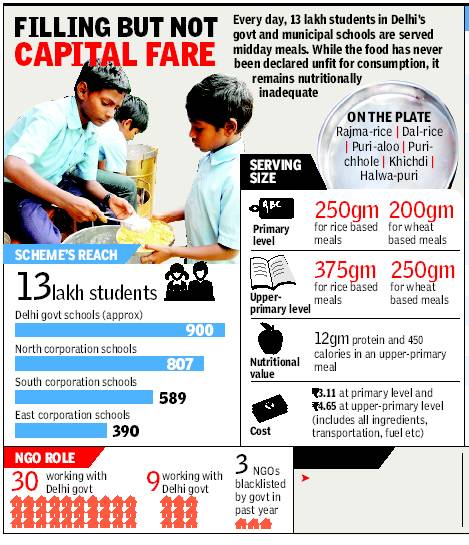Midday Meal Scheme: India
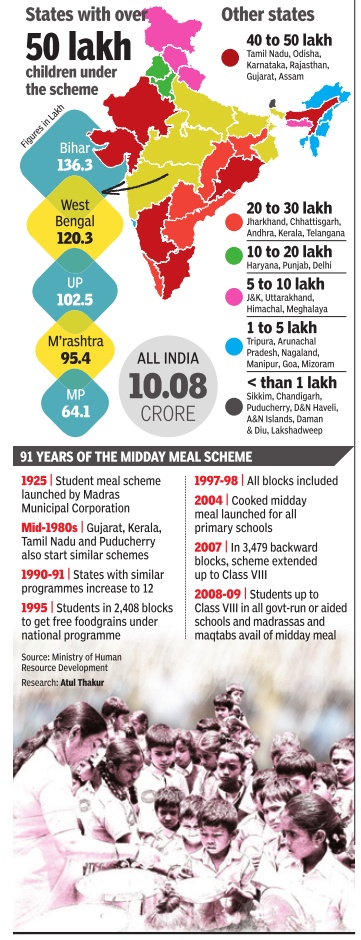
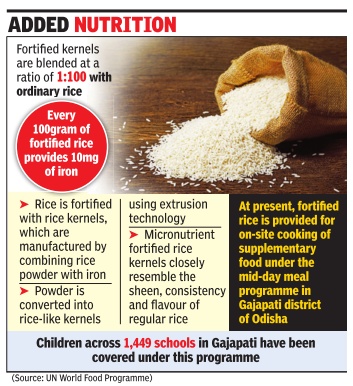
This is a collection of articles archived for the excellence of their content. Readers will be able to edit existing articles and post new articles directly |
Contents |
History
THE GROWING SCHEME
The Times of India 2013/07/18
Aug 15, 1995 | Union govt launches Midday Meal Scheme in 2,408 blocks as a dry rations scheme. Based on scheme running successfully in Tamil Nadu since 1960s. By 1997-98 introduced in all blocks
April 2002 | Cooked meals scheme extended to all Government-assisted primary schools, local body schools
Sept 2006 | Nutrition boost to scheme: Cooked meal with 450 calories, 12g protein to kids in primary classes (I-V)
April 2008 | Scheme expands to include all kids studying in schools and learning-centres like madrassas etc supported under Sarva Shiksha Abhiyan
By 2011-12, Over 2.4 million cooks/helpers mostly women engaged. Over 570,000 kitchens and stores in schools
2013: 10.7 crore children under scheme
Nutritional and hygienic servings have been major challenges in most states
Several scams busted where food-grain is pilfered, poor quality meals served
The economics
Implementation, region/state-wise
Midday Meal Scheme in Delhi
QUALITY ISSUES in Delhi
The Times of India 2013/07/19
Meal quality is average and portions are smaller than prescribed size
Many students (7-13%) are not served meals in a day
None of the surveyed schools have kitchen sheds
Potable water is scarce, especially for the 2nd shift boys’ schools
Children are not encouraged to wash their hands before and after meals
Usually, suppliers receive food grains 50 days after supplying meals
Most schools do not display menus or the midday meal logo
Cooks-cum-helpers do not meet government norms
Schools do not discuss the meal scheme with parents Most schools do not maintain a receipts register for meals
(*Findings of the 4th Half-Yearly Monitoring Institution Report (April-September 2012) for the city’s East and Northeast districts)
CONCERNS
Meals deficient in vital vitamins and micro-nutrients.
In 2012, the corporations found 83% meals nutritionally deficient
Service hygiene | Utensils and dining areas often unclean; 3 incidents of food poisoning in the past three years
Budget | Cost per meal should be increased to at least Rs5
Midday Meal Scheme in Tamil Nadu
Shanmughasundaram J, July 21, 2020: The Times of India
India’s first mid-day meal was served here, but now it is in lockdown
Shanmughasundaram J
TNN
Jul 21, 2020, 13:24 IST
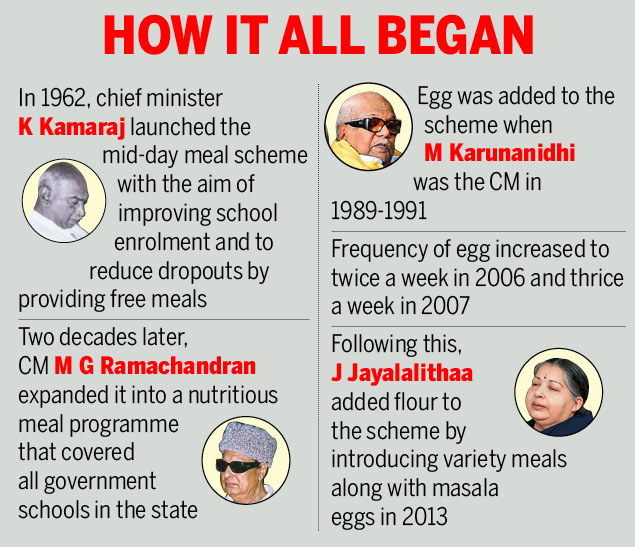
From: Shanmughasundaram J, July 21, 2020: The Times of India
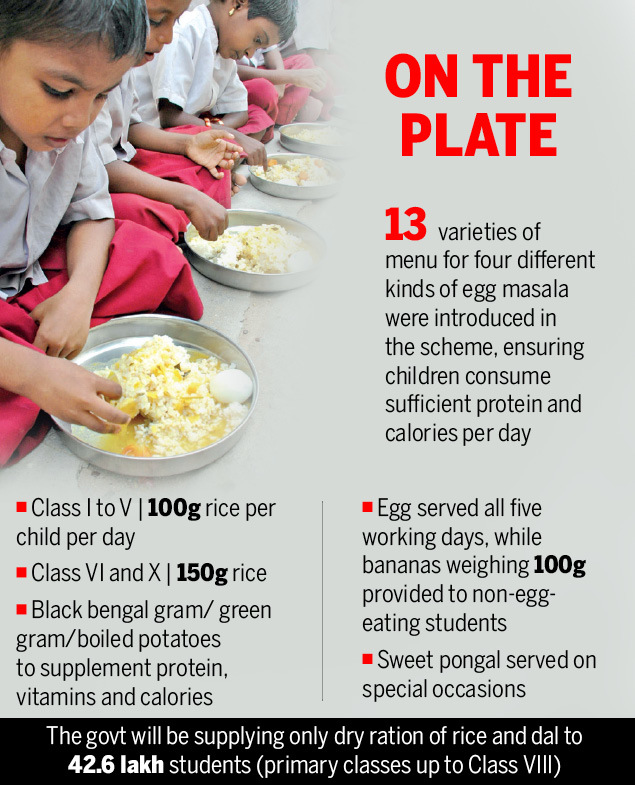
From: Shanmughasundaram J, July 21, 2020: The Times of India
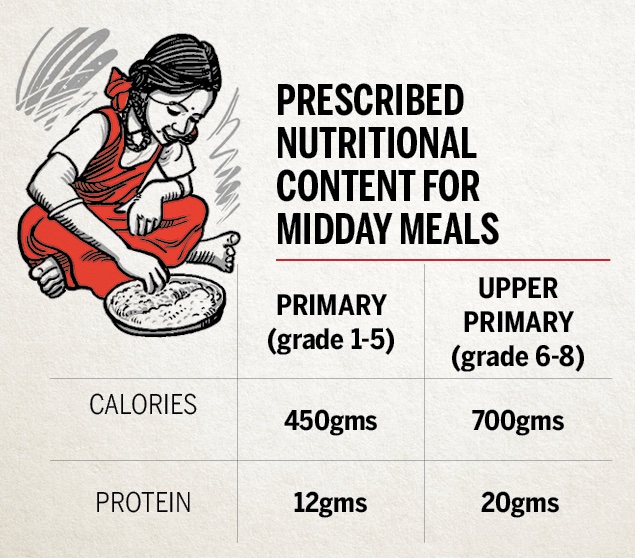
From: Shanmughasundaram J, July 21, 2020: The Times of India
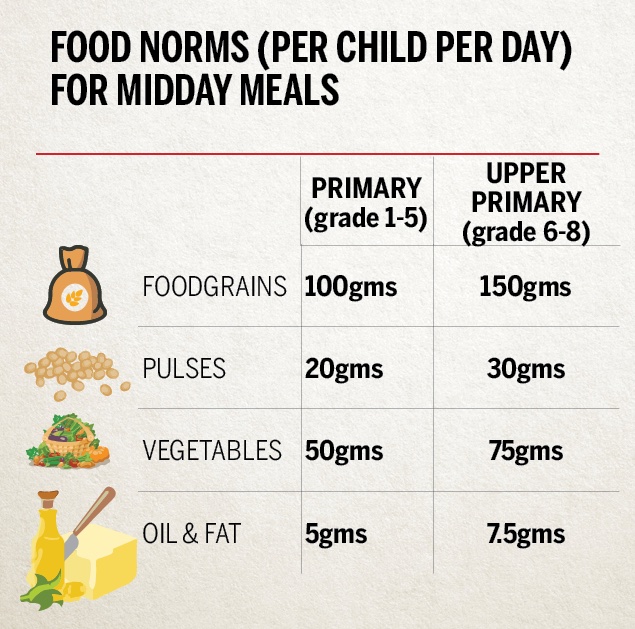
From: Shanmughasundaram J, July 21, 2020: The Times of India
This nutritional routine in schools that began in Tamil Nadu and spread across the country. In 1956, chief minister K Kamaraj launched the midday meal scheme with an aim to improve school enrolment and to reduce dropouts by providing free meals. Kamaraj’s encounter with a group of boys grazing livestock near a railway level crossing at Tiruneveli’s Cheranmahadevi gave birth to the idea for the scheme. When he asked why they were there rather at the school, one of the boys retorted, “If I go to school, will you give me food to eat?” This led to the launch of the noon meal scheme.
Going to school meant getting nutritious meals for thousands of children living in slums and pavement in cities like Chennai to remote villages in rural Tamil Nadu.
The objective of the Puratchi Thalaivar MGR nutritious meal programme, as it is known today, according to the government, is to emphasise on education along with nutrition to 48.6 lakh students in the state.
Since the 1960s, subsequent governments have helped develop the scheme. In 1982, CM M G Ramachandran expanded it across the state, covering all government schools. Though DMK chief M Karunanidhi initially opposed the scheme, he continued to support it and introduced egg in noon meals fortnightly in 1989. Later, he made the provision to serve eggs thrice a week in 2007. Following this, CM J Jayalalithaa added flavour to the scheme by introducing variety meals along with masala eggs in 2013.
2011-15: Cost per child
U.P.: 2013-19
Ishita Bhatia & Deepak Lavania, Sep 11, 2019: The Times of India
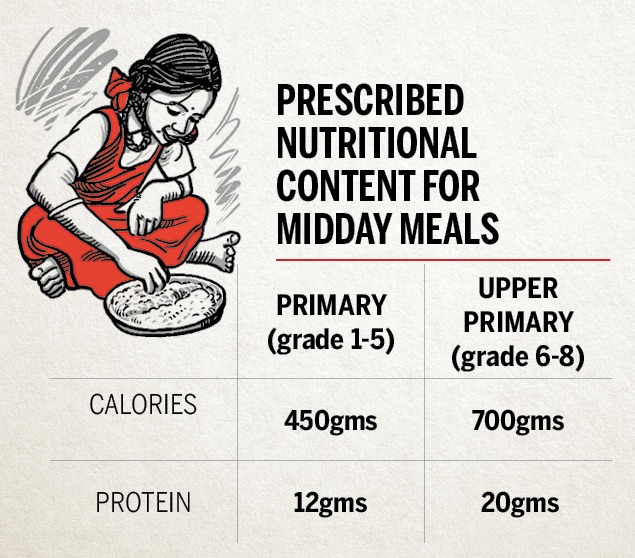
From: Ishita Bhatia and Deepak Lavania, Sep 12, 2019: The Times of India

From: Ishita Bhatia and Deepak Lavania, Sep 12, 2019: The Times of India
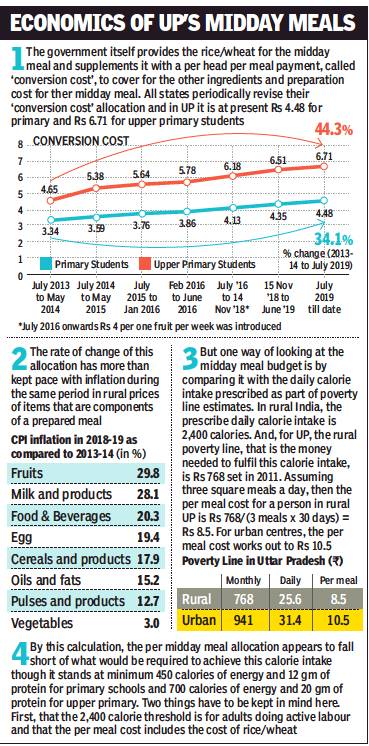
From: Ishita Bhatia & Deepak Lavania, Sep 11, 2019: The Times of India
The issue of substandard food served as midday meal is in the spotlight after a video of kids in UP’s Mirzapur being given salt and chapati grabbed headlines. Decades after it was rolled out, the midday meal scheme — which aims to boost nutrition and attendance in school — remains riddled with organisational and logistical issues. Non-compliance with nutritional norms, poor quality food and delay in clearance of dues plagues the scheme in UP despite the state announcing Rs 2,000 crore for midday meals in its 2019-20 budget.
The UP government has now announced that it will conduct audits of food served to children. For this, external agencies, including IIM-Lucknow, Govind Ballabh Pant Social Science Institute and Lucknow University will be roped in. Vijay Kiran Anand, director, Mid Day Meal Authority, told TOI that a blueprint for the audit process is being readied. He added that it was the verification process that was causing the delay in disbursing money. “District officials have to check utilisation of previous funds, hence the delay.” However, “instructions have been issued to transfer the money within a week”.
In Agra, a teacher said they had not received funds to cover midday meal costs for several months. Many schools haven’t received money for fruits for 18 months. “Even payment of cooks has been pending for long,” said Rajeev Verma, general secretary of primary teachers’ association in Agra. Omkar Singh, the basic shiksha adhikari (BSA) in Agra, admitted there was delay in disbursing funds but that “all schools will get funds within the next few days”.
While the government provides wheat and rice to schools directly, funds for all other supplies, conversion costs — expenses for vegetables, pulses, LPG, spices and oil — and salaries of cooks are released by Mid Day Meal Authority to district-level BSA offices, which then transfer the money to school management committees. In some urban centres, NGOs implement the scheme.
But teachers said that conversion costs of Rs 4.48 (primary) and Rs 6.71 (upper primary) per child per day were too little. “The government has also asked us to squeeze in expenses on milk in conversion costs. It’s just not possible,” said a primary school teacher.
Thus, milk — added on the menu in 2015 and an essential component of a nutrient rich diet — is out of reach for most. “There are 300 students in my school and according to norms at least 45kg of milk should arrive for distribution every Wednesday, but we get only 3.5 to 4 kg. The only way to ensure that all students get milk is to add water to it,” said an assistant teacher in Meerut.
According to norms, primary students (up to Class V) are supposed to get 150ml of milk each and upper primary students (from Class VI to VIII) 200ml of milk each on Wednesdays. Seasonal fruits, another addition to the thali in 2016, remain mostly confined to bananas. The government provides Rs 4 per child for one fruit serving per week.
A school kid in Meerut said that tasteless watery gruel served in place of daal is forcing him and a few others to bring lunch from home. “The chapatis are stiff, cold and often half-cooked,” the class 5 student said.
Teachers are often in a dilemma: Watch students go hungry or spend from their own pocket. Many choose the latter. Headmaster of a government-aided school at Umarpur Neewa in Allahabad said, “Through the years, I must have paid about Rs 50,000 to ensure kids have good meals.”
With inputs from Harveer Dabas and Vinod Khanal
Cost
2011-15
The Times of India, Aug 01 2015
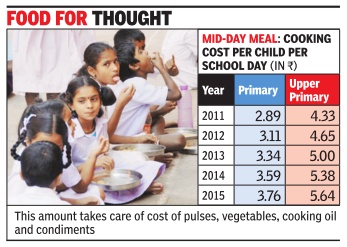
Slim hike in cooking costs adds to midday meal woes
Akshaya Mukul
There can be a healthy subsidy for food for MPs in Parliament but for 12 crore children availing of midday meals, grants continue to come in trickles. After 50 children in Lucknow fell ill consuming milk under the midday meal scheme, HRD ministry hiked the cooking cost of meal per primary child by 17 paise and per upper primary child by 26 paise from 2014. Sources said this will only deepen the crisis in MDM scheme that got only Rs 9,000 crore in this year's budget though HRD demanded Rs 16,000 crore. The new cooking cost has been hiked by 5%, unlike 7% in the past and stands at Rs 3.76 per primary school child and Rs 5.64 per upper primary school child. The abysmal amount includes cost of cooking oil, pulses, vegetables and condiments.
Qualitative issues with the food
2012-13: Incidents when food poisoning took place
See graphic:
Midday Meal Scheme: The July 16 incident refers to the year 2013
Judicial judgments
Teachers should not be asked to supervise cooking of meals: HC
The Times of India, Jul 25, 2013
ALLAHABAD/PATNA: The duty of school teachers and principals is to teach students and not to supervise cooking of meals, the Allahabad high court has observed, close on the heels of Bihar midday meal tragedy.
The observation by the court in Uttar Pradesh came even as three lakh primary school teachers across Bihar boycotted midday meal duties on the grounds they interfered with teaching work.
"The duty of teachers and principals of schools is to teach the students and not to supervise the cooking of meals," a division bench comprising Justice Shiva Kirti Singh and Justice Vikram Nath observed yesterday amid questions whether teaching staff at government schools should be saddled with the implementation of the scheme.
The court was hearing a PIL filed by Meerut-based UP Pradhanacharya Parishad.
Government had asked principals, rather than NGOs, to supervise the cooking
The PIL had challenged an order of the district inspector of schools, dated June 19, whereby the earlier system of NGOs being entrusted with preparing midday meals was scrapped and principals were directed to get the food prepared in their respective schools under their personal supervision.
The petitioners had contended that the new system would interfere with the duties of teachers in Meerut and pointed out that NGOs were taking care of midday meals in a number of neighbouring districts.
Expressing surprise over the submission, the court said, "There must be uniformity across the state with regard to who shall be entrusted with a specific task like preparing midday meals".
The court ordered that in Meerut, the previous system (of NGOs preparing midday meals) would continue until further orders.
Millets in midday meals
They boost child growth: 2019 Study
Vishwa Mohan, Dec 19, 2019 Times of India
In a first ever scientific study of its kind in schools, millet based midday meals were found to significantly boost child growth in terms of body mass index (BMI), nutrition and also can be a better rice substitute in India. Findings of the study published in the journal Nutrients were released on Wednesday by NITI Aayog member Ramesh Chand, and CEO of the National Rainfed Area Authority, Ashok Dalwai. Both of them spoke about nutritional value of millets and also on how it could promote sustainability.
The study — ‘Acceptance and impact of millet based mid-day meal on nutritional status of adolescent school going children in a peri-urban region of Karnataka state in India’ — may help in creating awareness among consumers and farmers for opting millets. The Centre has also allowed inclusion of millets in the Public Distribution System for improving nutritional support.
The millet-meals study was conducted by NGOs — International Crops Research Institute for the Semi-Arid Tropics (ICRISAT) and the Akshaya Patra Foundation — in government schools in four villages .
Millet-based mid-day meals were fed to 1,500 adolescent children at two schools, of which 136 were studied as an intervention group and were compared with 107 other children in two other schools that did not receive the intervention.
The study said that the introduction of millet-based meals in school feeding programmes can significantly improve the nutritional outcome of children compared to fortified rice-based meals. The government had last year even increased the minimum support price of millets so that farmers may opt for it as alternative to water-guzzling crops such as paddy and sugarcane. Procurement of millets has, however, not yet picked up.
See also
Monocrotophos pesticide: India, that being the poison responsible for the Bihar deaths of 2013.
